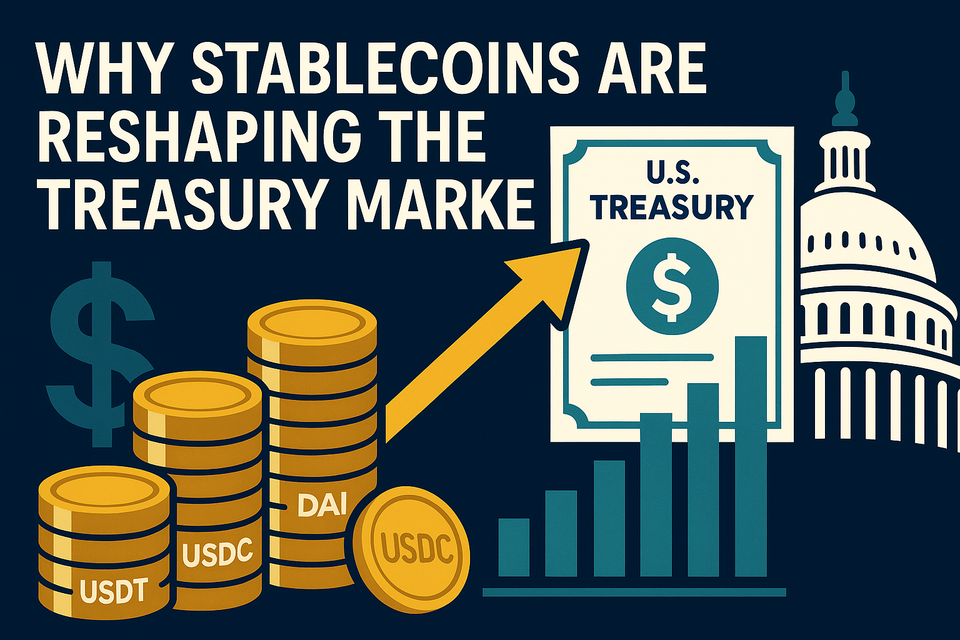Why Stablecoins Are Quietly Reshaping U.S. Treasury Markets

Summary
U.S. dollar-backed stablecoins now hold over $166 billion in short-term Treasuries—more than many sovereign nations.
Driven by yield opportunities and real-time settlement benefits, their rise is shifting the dynamics of both crypto and traditional finance.
But this concentration is creating ripple effects: from suppressed yields to growing regulatory urgency.
Introduction: The Rise of “Digital Dollars” Backed by U.S. Debt
In mid-2025, the global stablecoin market hit $247 billion—equivalent to the GDP of Portugal.
At the heart of this explosive growth is a subtle yet seismic transformation: private issuers like Tether and Circle are becoming some of the largest buyers of U.S. Treasury bills.
Tether alone now holds over $120 billion in short-term Treasuries, more than Germany. This capital inflow is no longer just a crypto story—it’s directly affecting the cost of borrowing for the U.S. government and the structure of dollar liquidity.
This trend is not just financial; it’s political, regulatory, and deeply macroeconomic.
Trend Breakdown
1. Stablecoin Market Structure (as of Q2 2025)
| Stablecoin | Market Cap | Key Holdings | Notes |
|---|---|---|---|
| Tether (USDT) | $151B | $120B+ in Treasuries | Largest holder among stablecoins |
| USDC | $39.7B | 44% in Treasuries | Gaining ground via Visa/Mastercard |
| DAI | $3.18B | Diversified, moving to USDS model | Declining share |
Emerging players like PayPal’s PYUSD ($775M) are growing quickly, while BUSD has nearly exited the market (<$58M).
2. Treasury Demand and Yield Dynamics
Stablecoin issuers now hold roughly $166 billion in U.S. Treasuries—mostly short-term bills under 93 days.
This positioning is reshaping Treasury demand:
| Metric | Value |
|---|---|
| Tether’s Holdings | $120B (more than Germany’s $111.4B) |
| Yield Impact | -2.5 bps for every $3.5B inflow into 3-month T-bills |
| BIS Observation | Outflows raise yields 2–3× more than inflows reduce them |
Stablecoins may soon become the third-largest T-bill buyer group globally.
Tether’s Q1 2025 operating profit exceeded $1B, largely from interest earned on Treasury reserves—outpacing many regional banks.
3. Legislative & Regulatory Shift
2023–2025 has seen bipartisan momentum in regulating stablecoins. Two landmark U.S. bills are reshaping the market:
- STABLE Act (House):
- Mandates 1:1 reserves (cash or sub-93-day Treasuries)
- Passed Financial Services Committee (32–17) in April 2025
- GENIUS Act (Senate):
- Prohibits Treasuries >3 months as backing
- Requires monthly audits and C-suite certifications
- Passed in June 2025
These frameworks aim to reduce systemic risks and improve transparency—without stifling innovation.
4. Stablecoins as Global Dollar Rails
Stablecoins now play a critical role in global dollar liquidity:
- $585B in USDC transfers (March 2025)
- Integration with Visa/Mastercard for real-time settlement
- Lower U.S. borrowing costs via T-bill demand
- BIS warning: could undermine Fed rate control if unmanaged
“Stablecoins are no longer just fintech toys—they’re becoming global monetary instruments.” — [BIS Report]
5. The CBDC Debate: Competition or Complement?
Rather than pushing a U.S. CBDC, regulators are now leaning toward stabilizing and co-opting stablecoin infrastructure:
- Pros:
- Private-sector agility and innovation
- Direct support for Treasury demand
- Cost-effective global transfers
- Cons:
- Drains bank deposits → tightens credit
- Fire-sale risk during mass redemptions
Some estimates suggest the GENIUS Act could save over $1 trillion in U.S. interest costs by 2026.
Why It Matters
This isn’t just a crypto or DeFi narrative. Stablecoins are:
- Altering the global demand curve for U.S. debt
- Creating new transmission channels for monetary policy
- Challenging traditional banking models and deposit structures
As they scale toward a projected $2 trillion market cap by 2028, they could become a pillar of U.S. macro policy—or its next headache if poorly regulated.
Takeaways
- Stablecoins have become systemic players in Treasury markets.
- Their yield-seeking behavior compresses short-term rates, benefitting issuers—but adding macro risk.
- U.S. legislation (STABLE, GENIUS Acts) is catching up fast to regulate reserves and transparency.
- Institutional usage (Visa, PayPal, Stripe) is anchoring stablecoins in real-world finance.
- Expect stablecoins to be a silent but powerful lever in U.S. monetary and fiscal policy debates.
Sources
- Stablecoin Q1 2025: Insights on Trends & Regulation – Amberdata
- Stablecoins’ step toward mainstream – Reuters
- Tether surpasses Germany’s US Treasury holdings – Cointelegraph
- Stablecoin Bills Advance in Congress – Debevoise
- Stablecoins and Safe Asset Prices – BIS PDF
- The GENIUS Act Interest Rate Implications – Investopedia
- BIS Quantifies Stablecoin Impact – Ledger Insights
- How Stablecoin Bill Helps Fund U.S. Deficit – CNBC
- U.S. Senate Passes Stablecoin Bill – Reuters
- Stablecoin Regulatory Framework Passes House – ICBA
- Meta, PayPal, Stripe & Stablecoins – CCN
- Stablecoin Regulation & Liquidity Shifts – Phemex
- The Future of Dollar-Based Payments – QED Investors
- CBDCs vs. Stablecoins – Atlantic Council
- Regulating Digital Dollars – BHFS
- Crypto Policy Regulation – Deloitte
- USDC Circulation Report 2025 – Circle
- Tether $120B Treasuries Confirmation – Tether
- MakerDAO’s $1B Tokenized Treasury Plan – Yahoo Finance
- Treasury International Capital Data – U.S. Treasury
- FRB Withdraws Crypto Guidance – Fintech & Digital Assets
- Top 213 Stablecoins – Statista
- Stablecoins as Financial Ally – Ark Invest
- Digital Money PDF – U.S. Treasury
- GENIUS Act Passes Senate – Fenwick
- GENIUS Act Explained – CNBC
- Stablecoin Market Battle – Axios
- Stablecoins Strategic Playbook – TreasurUp
- Stablecoin Regulation – Faster Payments Council
- Stablecoins vs. CBDCs – Forbes
- USDC Reserve Report PDF – Circle
- State of Stablecoins Part 1 – Bastion
- Stablecoin Legislation & T-bill Demand – WSJ
- GENIUS Act Overview – TRM Labs
- Stablecoins 2025 – DigFin
- PwC Global CBDC Index PDF
- Stablecoins to the Treasury’s Rescue – RIA
- Stablecoin Regulation – Global Legal Insights
- Wildcat Banking 2.0 – OMFIF
- Stablecoins and Digital Euro – EU Parliament PDF
- Stablecoin Revolution – AInvest
- Stablecoin Surge – World Economic Forum
- State of Stablecoins Part 3 – Bastion
- Top Stablecoins by Market Cap – CoinCodex
- Stablecoin Statistics 2025 – SoCap
- Market Surge Q1 2025 – AInvest
- Stablecoin Market Cap 2021–2025 – Statista
- Stablecoin Cap Surge to $228B – AInvest
- USDC vs. USDT 2025 – CoinBureau
- Top Stablecoins – Forbes
- Stablecoins Changing Monetary Meaning – Bastion
- What Are Yield-Bearing Stablecoins? – CoinBureau
- 10-Year Treasury Yield & Crypto – Cointelegraph
- GENIUS Act Summary – U.S. Congress



